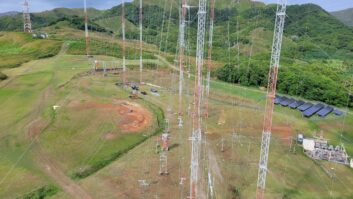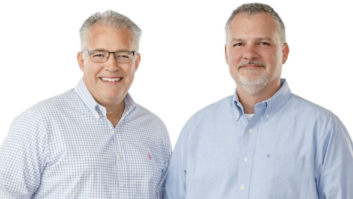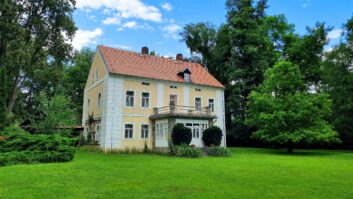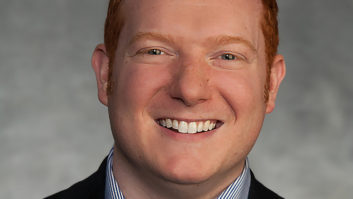It was August 1941, just a few months before the tragic events now known worldwide as Pearl Harbor.
President Roosevelt called a meeting of prominent radio personnel at the White House to establish an international broadcasting network, which has since become the Voice of America.
One of the well-known radio personnel present was Wesley Dumm, who had been successful in medium-wave broadcasting in California for the last decade or so.
During the White House meetings, the president asked Dumm to build two shortwave stations in the San Francisco area for coverage into the Far East.
FDR stated that both NBC and CBS had been invited to install shortwave stations in California, but both had declined due to huge financial losses at their shortwave stations already on the air with programming beamed to Latin America. Congress would not appropriate funding for this new international radio project, the president stated, so he would make payment out of discretionary funds available at the White House.
(click thumbnail)Pre-war postcard shows the hotel that housed studios for KWID and KWIX for a time during World War IAmerican voice
Things began to move quite rapidly.
The government bought the new 100 kW GE transmitter that had recently come into service as W2XAF-WGEO at Schenectady, N.Y. In the meantime, work was underway at Islais Creek, on the Bay Shore a little south of San Francisco, where an extension was constructed to the transmitter building of the medium-wave station, KSFO.
The antenna farm for the shortwave facility covered a total of 11 acres. In due course the shiny new 100 kW GE unit from the East was installed here, and test broadcasts commenced on May 4, 1942.
Originally, the projected call sign for this unit, which already had been on the air in Schenectady under the call signs W2XAF, WGEU and WGEO, was KABI. Wesley Dumm had earlier initiated a small network of regional medium-wave stations in California as Associated Broadcasters Inc. The new shortwave station would be the international service of this network, hence KABI.
However, before the new shortwave station went on the air, another call sign was chosen, this time the now more familiar KWID. If you look carefully, you will notice that Wesley Innes Dumm’s initials were WID.
The purpose for this new shortwave station was to act as an American voice across the Pacific, and to supplement the broadcast programming from the first and only other shortwave broadcasting station on the air in California at the time, KGEI in nearby Belmont.
Initially, the programming for this new shortwave transmitter was produced and coordinated in a suite of radio studios located on the 17th floor of the Mark Hopkins Hotel at the Nob, overlooking San Francisco and the Pacific.
These temporary studios were in use for the production of programming for the medium-wave unit, KSFO. Four months later, a new studio suite was completed as an annex to the Mark Hopkins, and KSFO moved into this facility.
The studios for the shortwave KWID were then relocated into what was considered to be a bomb-proof location under the hotel in the basement that is now the parking garage. However, at about the same time, the newly formed Office of War Information took over the NBC studios at 111 Sutter Street in San Francisco, and much of the KWID programming was transferred to this location, using the personnel from the shortwave studios in the Mark Hopkins Hotel.
Record-breaking operation
While these other international radio events were transpiring, provision was made for the installation of an additional shortwave transmitter at Islais Creek.
The 100 kW GE KWID transmitter was installed in the extension on the north side of the medium-wave building, and it would appear that a similar extension on the south side of the building housed the subsequent 50 kW RCA unit, which was given the family call sign KWIX. Even though the power outputs were different, the physical size of both transmitters was the same at 68 feet long.
(click thumbnail)The first broadcasts from the new KWIX were heard in mid-year 1943, a little more than a year after the launching of the earlier KWID. Both units were heard in Asia and the South Pacific with excellent signals, as many monitoring reports indicate.
Soon after the OWI office was opened on Sutter Street, all shortwave programming was produced and coordinated at this location. Initially, the KWID programming also was heard on relay from KRCA and KES in Bolinas, and soon afterwards from the communication transmitters located at Dixon that were identified with the program call signs KWD, KWU, KWV and KWY.
Both Bolinas and Dixon are in California, a little north of San Francisco. In fact, the United Network with KWID at the helm, which comprised all of these shortwave stations in the San Francisco area, even took over the programming on behalf of the illustrious GE station, KGEI.
On one occasion, in March 1943, the programming from the California KWID was heard in Australia on relay over the big gospel station in Ecuador, HCJB, the Voice of the Andes. At the time of the surrender broadcasts from Tokyo Bay on August 14, 1945, the programming from KWID was heard on relay via the Voice of America station, KRHO, in Hawaii.
It is apparent that the shortwave signal from the KWID transmitter propagated widely into the coastal areas of the Pacific; this is demonstrated in many ways in many countries.
Another example of this wide impact: The Chinese ambassador to the United States made a request to the U. S. State Department on July 4, 1943 for the Spanish programming from their own shortwave station, XGOY in Chungking, to be relayed by KWID to Latin America. The United States denied the relay request as a matter of foreign policy at the time.
Nine signs
In July 1950, the call signs of the stations in the VOA shortwave network were consolidated, and KWID became KWID1 and KWIX became KWID2.
The final day of broadcasts from the 100 kW KWID1 and the 50 kW KWID2 was a regular relay from the Voice of America, and it took place exactly three years later on June 30, 1953. VOA was operating twin stations at Dixon and Delano in California, and Islais Creek was no longer needed.
But that was not the end. Three years later, the Far East Broadcasting Co. in the Philippines bought the two transmitters at Islais Creek with the intent of installing them in its new transmitter building on the edge of Manila. As fortune would have it, the 100 kW from Schenectady and Islais Creek was instead modified for medium-wave usage and installed as KSBU on the island of Okinawa.
A few years later when Okinawa was handed back to Japan, this transmitter was re-modified back to shortwave usage and installed as the first transmitter at KFBS on the island of Saipan.
The 50 kW RCA unit was indeed installed by FEBC Manila for shortwave coverage into Asia under the call sign DZF. Both of these illustrious transmitters have since been discarded and replaced by more modern units.
To the credit of the president, he did make payment to Wesley Dumm for the costs of establishing and operating this, the second shortwave station in California. The payment came from the president’s discretionary funds in the White House, a bit more than just pocket money.
One final note: If the Guinness Book of Records offered such a category, the 100 kW shortwave transmitter would surely take the prize for operation in the most locations under the most call signs. Locations? Four: Schenectady, Islais Creek, Okinawa and Saipan. Call signs? Nine: W2XAF, WGEO, WGEU, WGEO again, projected KABI, KWID, KWID1, KSBU, and finally KFBS.
RW welcomes photos from these stations to share with our readers.
Dr. Adrian M. Peterson is a board member of the National Association of Shortwave Broadcasters. He was born in South Australia in 1931; since 1944 he has since written several thousand articles on radio history, which have been published in 25 languages. He is advisor to the program “Wavescan” and coordinator of international relations for Adventist World Radio.
He wrote “WCAU Used Shortwave in Philadelphia” in the Aug. 15, 2007 issue.














